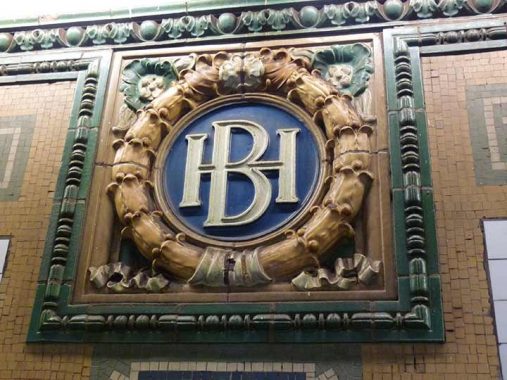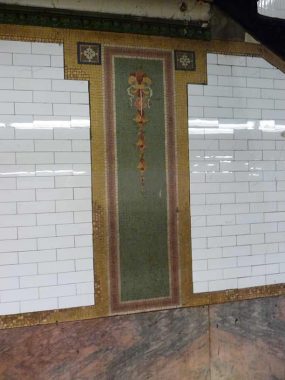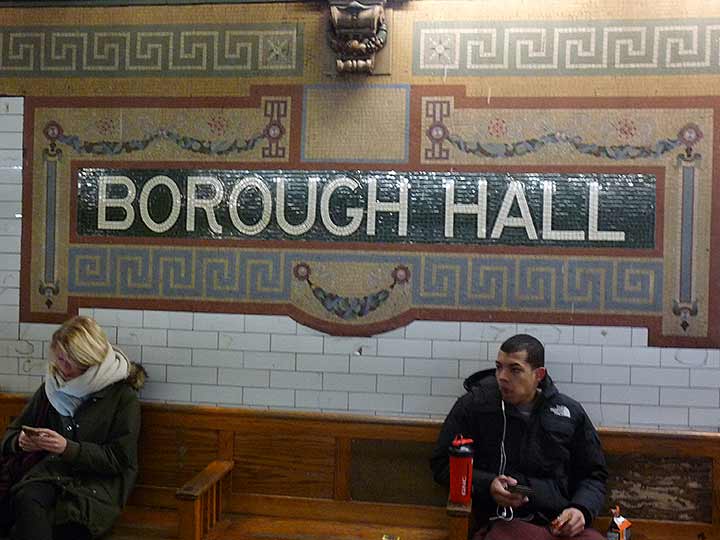
I like to say that Forgotten New York is not only a website that tries to shine a light on parts of New York City that don’t make the guidebooks, it’s also an infrastructure website in which I point out aspects of NYC public works that interest me. It’s by no means comprehensive: for a more complete look, including things like sewers or power plants, I’ll direct you to Kate Ascher’s indispensable 2007 book “The Works: Anatomy of a City.”
Today I will mention Brooklyn’s Borough Hall station, which is actually a complicated mashup of three different stations stacked atop or close to each other: The IRT Borough Hall station, serving #4 and 5 trains (1908); the second IRT Borough Hall station serving #2 and 3 trains (1919); and the BMT Court Street station serving R trains most of the time (1916). All three lines can transfer to each other.
It’s the 1908 Borough Hall station that interests me the most. It was once a terminal as the original 1904 subway was extended south from Manhattan’s City Hall to the wilds of Brooklyn four years later. 1908 was also the peak of the subways’ Beaux Arts period with ornate stations designed by architects George Lewis Heins (1860–1907) and Christopher Grant LaFarge (1862–1938) and the pair spared no expense at Boro Hall; architect Heins did not live long enough to see the IRT’s original Brooklyn expansion.
In the title card photo above, you see the mosaic station ID tablets featuring straightforward geen tiles with white lettering surrounded by buff and blue decorative mosaic work.

It’s in the bas relief wreaths and “BH” in white on a blue background that Heins & LaFarge went all out, with etrra cotta work created by the Hartford Faience Co., with mosaic versions at the end of the platform done by American Encaustic Tiling. These creations represent an early apotheosis of subway design. So much so that this station has been granted NYC Landmarks Preservation Commission protection. Some of the mosaic tablets have suffered from neglect over the years and await repair.

Mosaic “tapestries,” once found more frequently in the system, can still be seen at Boro Hall, 72nd Street (IRT) and 110th Street (IRT). Also note the marble or marble-look panels on the bottom.
As always, “comment…as you see fit.” I earn a small payment when you click on any ad on the site.
2/21/23


9 comments
Borough Hall #4/#5 station served as the IRT’s original southern terminal for a bit under four months. The IRT opened on January 9, 1908 between Bowling Green (Manhattan) and Borough Hall using the Joralemon Street tunnel, the first subway tunnel between the two boroughs. May 1, 1908, the IRT was extended further to Atlantic Avenue, which later became another large IRT-BMT transfer complex.
IRT trains from Manhattan terminated at Atlantic Avenue until 1920, when the lines were extended into the real wilds of Brooklyn, using then-new routes under Eastern Parkway and Nostrand Avenue, and atop Livonia Avenue east of Utica Avenue. Those lines opened in 1920-22 and extended the IRT to its current terminals in Flatbush at Brooklyn College, and in East New York at New Lots Avenue.
What are the “marble-look” panels made of?
They could be marble. That’s why I said marble or marble-look.
The original Borough Hall station was my first “home” station when I moved to the city in 1980. There was a cigarette and candy stand near the front of the inbound platform that was run by a young Indian couple. I thought the wife was the most beautiful woman I had ever seen and was always sure to give them my cigarette habit business every morning. Several years in she became pregnant and began to show. Then the MTA closed down the stand to renovate the station. The stand and the young couple never returned. To this day I still think about them and wonder if they found familial happiness. One of the eight million stories . . .
I don’t know when it returned, but the candy stand has been open since at least 2008 when my job transferred me to our Brooklyn office and Borough Hall became my work station. The operator (owner?) is an Indian gentleman.
Tim. Are you the Tim Farrell that worked at Chase ?
It really is a beautiful station. You could tell how much less interest the IRT company had in station beautification by the design of the 2/3 Borough Hall
station. This was a Dual Contracts station and really has very few of the artistic touches that the 4/5 station. One of my clearest memories of the 4/5 station
is an event that happened about 10 years ago. I was standing near the southern end of the uptown platform. There was a huge mound of garbage bags,
probably waiting for loading on the garbage train. I suddenly heard a rustling sound coming from the mound and then I saw two of the biggest rats I have
ever seen run out of the mound and into the tunnel. I never knew rats could get that big.
Hey Tim , TV & radio news often use the terms “inbound” and “outbound” in referring to Manhattan. As a resident of Brooklyn, I feel slighted in the insinuation that New Jersey, Queens, the Bronx, Staten Island and Brooklyn are inconsequential to the fabric that makes the NYC metropolitan region. Plus, saying “Queens bound” or “Bronx bound” is easier to grasp for an out-of-towner who’s not familiar with the metropolitan area’ s geography.
When my train arrives at Borough Hall station
I always feel a bit festive inside for the beauty
and promise it inspires.